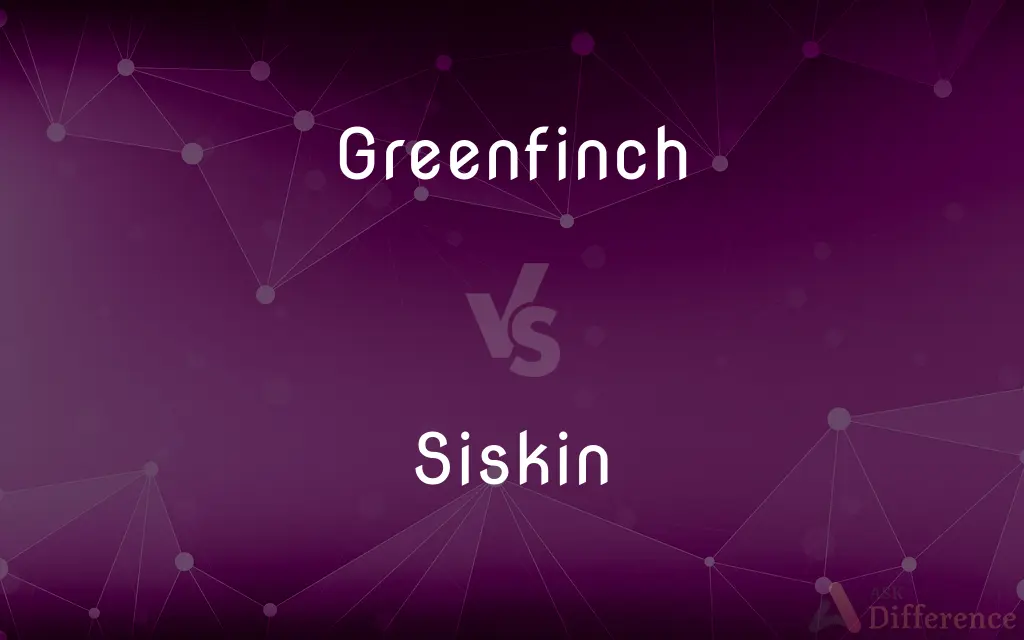Greenfinch vs. Siskin — What's the Difference?
By Fiza Rafique & Maham Liaqat — Updated on April 2, 2024
Greenfinches are stout, olive-green birds in Europe/western Asia. Siskins, smaller with yellow-green plumage, inhabit coniferous forests.

Difference Between Greenfinch and Siskin
Table of Contents
ADVERTISEMENT
Key Differences
Greenfinches, with their distinct olive-green coloration and heavier build, are easily recognizable in their habitats, which range from woodlands to gardens. They have a strong presence in Europe and parts of western Asia, adapting well to both wild and urban environments. Siskins, on the other hand, are more diminutive and agile, with striking yellow-green plumage that makes them a vibrant presence in mainly coniferous forests. Their size and coloration are adapted to blending into their primarily woodland environments.
The diet of a greenfinch primarily consists of seeds and grains, reflecting their adaptation to a variety of environments, including garden feeders where they are often observed. Their stout beak is perfectly suited for cracking open seeds. Siskins, while also seed eaters, often favor the seeds of coniferous trees, aligning with their forested habitats. Their slimmer beak allows for more precision in extracting seeds from cones.
Breeding habits of greenfinches involve building relatively robust nests in bushes or trees, laying about 4-6 eggs. They are less migratory and tend to stay within their range throughout the year. Siskins, however, exhibit more flexibility in breeding locations, often nesting in conifer trees and displaying a greater tendency to migrate, especially outside the breeding season, in search of food sources.
The vocalizations of greenfinches are characterized by a range of tweets and trills, serving as communication and during mating rituals. Their calls are deeper compared to siskins. Siskins have a more delicate and high-pitched song, which, along with their call notes, reflects their lively and social nature, especially evident in their acrobatic flight patterns.
In terms of social behavior, greenfinches can often be found in small flocks, especially in winter, around food sources. They show a mix of territorial and communal behaviors. Siskins are known for their gregariousness, forming larger flocks, particularly in the non-breeding season, and frequently mixing with other finch species, showcasing a more distinctly social nature.
ADVERTISEMENT
Comparison Chart
Size & Build
Larger, robust body with a stout beak
Smaller, slender body with a finer beak
Coloration
Olive-green plumage
Vibrant yellow-green plumage
Habitat
Europe and western Asia; woodlands to urban
Mainly coniferous forests
Diet
Seeds and grains; adaptable to feeders
Primarily seeds of coniferous trees
Breeding & Nesting
Builds in bushes or trees; less migratory
Prefers conifer trees; more migratory
Vocalizations
Deeper tweets and trills
High-pitched song and calls
Social Behavior
Small flocks; mix of territorial and communal
Gregarious; forms large flocks, often with other species
Compare with Definitions
Greenfinch
Exhibits less migratory behavior, showing strong territorial instincts.
The greenfinch remains near its breeding grounds year-round.
Siskin
Sings a delicate, high-pitched song.
The forest echoed with the siskin's melodious song.
Greenfinch
Vocalizes with a series of tweets and trills.
The song of the greenfinch filled the early morning air.
Siskin
A small, agile bird with yellow-green plumage, often found in coniferous forests.
The siskin flitted through the pine branches with ease.
Greenfinch
Forms small flocks, especially in winter.
A small flock of greenfinches gathered at the feeder.
Siskin
Diet consists mainly of conifer seeds.
Siskins were seen extracting seeds from a pine cone.
Greenfinch
A common bird in Europe and western Asia, known for its olive-green feathers.
The greenfinch's vibrant plumage blends into the garden's foliage.
Siskin
Known for its migratory patterns, especially in search of food.
As winter approaches, siskins migrate to warmer areas with abundant food sources.
Greenfinch
Feeds primarily on seeds, demonstrating adaptability.
A greenfinch was spotted cracking sunflower seeds at the feeder.
Siskin
Displays gregarious behavior, forming large, mixed-species flocks.
A large flock of siskins and goldfinches was observed feeding together.
Greenfinch
The greenfinches are small passerine birds in the genus Chloris in the subfamily Carduelinae within the Fringillidae. The species have a Eurasian distribution except for the European greenfinch, which also occurs in North Africa.
Siskin
The name siskin when referring to a bird is derived from an adaptation of the German dialect words sisschen, zeischen, which are diminutive forms of Middle High German (zîsec) and Middle Low German (ziseke, sisek) words, which are themselves apparently of Slavic origin.
Greenfinch
A widespread Eurasian finch (Carduelis chloris) having green and yellow plumage.
Siskin
Any of several small finches, such as Spinus spinus, a greenish-yellow finch of Eurasia and northern Africa, or the pine siskin of North America.
Greenfinch
Any of five distinct species of bird formerly within the genus Carduelis, now making up genus Chloris (Cuvier):
Siskin
A small green and yellow European finch, Carduelis spinus spinus or Carduelis spinus, now Spinus spinus.
Greenfinch
The European greenfinch, a common Old World finch, Carduelis chloris, now Chloris chloris, that is mainly green with yellow in the wings and tail.
Siskin
Any of various similar birds in subfamily Carduelinae, principally in the genus Spinus.
Greenfinch
The black-headed greenfinch, Carduelis ambigua, now Chloris ambigua
Siskin
A small green and yellow European finch (Spinus spinus, or Carduelis spinus); - called also aberdevine.
Greenfinch
The Oriental greenfinch, Carduelis sinica, now Chloris sinica
Siskin
Small sharp-billed yellow-and-black Eurasian finch
Greenfinch
The Vietnam greenfinch, Carduelis monguilloti, now Chloris monguilloti
Greenfinch
The yellow-breasted greenfinch, Carduelis spinoides, now Chloris spinoides
Greenfinch
A European finch (Ligurinus chloris); - called also green bird, green linnet, green grosbeak, green olf, greeny, and peasweep.
Greenfinch
The Texas sparrow (Embernagra rufivirgata), in which the general color is olive green, with four rufous stripes on the head.
Common Curiosities
What distinguishes greenfinches from siskins in appearance?
Greenfinches are larger with olive-green plumage, while siskins are smaller with yellow-green plumage and more slender builds.
Can greenfinches and siskins share the same habitat?
They can overlap in some woodland and garden areas, but siskins prefer coniferous forests.
How do the social behaviors of greenfinches and siskins compare?
Greenfinches form small flocks and are somewhat territorial, whereas siskins are very gregarious, forming larger flocks and often mixing with other finch species.
Which bird is more agile in flight, the greenfinch or the siskin?
The siskin is more agile in flight, reflecting its lifestyle in dense forests.
How do the vocalizations of greenfinches and siskins differ?
Greenfinches have deeper calls and songs, while siskins produce delicate, high-pitched vocalizations.
Do greenfinches migrate?
Greenfinches are less migratory and tend to stay within their range throughout the year, unlike siskins, which are more prone to migration.
What are the breeding habits of greenfinches compared to siskins?
Greenfinches build robust nests in bushes or trees and are less migratory. Siskins nest in conifer trees and show greater migratory tendencies.
Is the greenfinch or siskin more adaptable to urban environments?
The greenfinch is more adaptable to urban environments, frequently visiting garden feeders.
Can greenfinches and siskins be found together in the same flocks?
Siskins are known to form mixed-species flocks, including with other finches, so it's possible, though less common for greenfinches due to their different habitat preferences.
Are both greenfinches and siskins seed eaters?
Yes, but their diets differ slightly in preference, with greenfinches being more adaptable to various seeds and siskins favoring conifer seeds.
Share Your Discovery

Previous Comparison
Untangle vs. Detangle
Next Comparison
Yhwh vs. YhvhAuthor Spotlight
Written by
Fiza RafiqueFiza Rafique is a skilled content writer at AskDifference.com, where she meticulously refines and enhances written pieces. Drawing from her vast editorial expertise, Fiza ensures clarity, accuracy, and precision in every article. Passionate about language, she continually seeks to elevate the quality of content for readers worldwide.
Co-written by
Maham Liaqat













































